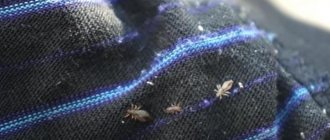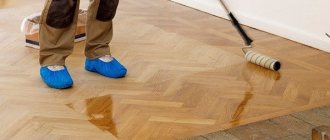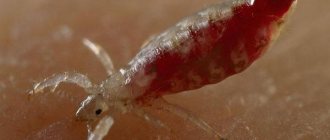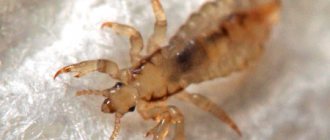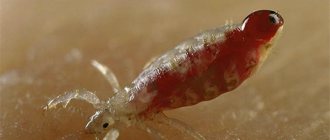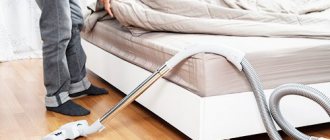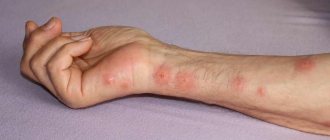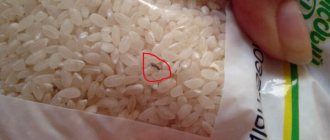How to deal with white insects in an apartment
To combat insects in a residential apartment, it is better to use drugs that are safe for humans, although in some cases (especially when the area is massively populated by parasites) chemically active agents will still be needed.
- The fight against silverfish should be comprehensive - first, clean the area from dust, dirt and cobwebs, and then treat it with chlorine-containing household chemicals. After waiting for the surfaces to dry, wipe all corners and hidden places with a solution of copper sulfate; it is advisable to dry the area using a fan heater (for small areas, a regular hairdryer is suitable). After a couple of hours, final cleaning with vinegar water is required - ½ cup of regular vinegar per bucket of warm water.
- Sugar silverfish most often grow in bookcases and shelves with papers, so these areas should be given special attention to eliminate the pest. Books and magazines should be rearranged and emptied, as eggs may be laid in them, and bookshelves can be sprayed with lemon water or thoroughly vacuumed.
- To eliminate food white midges, you will have to throw away all bulk food: even if you do not see bugs there at the moment, this does not mean that the cereal is clean. There are already numerous parasite eggs in it, and in a few days the insects will appear again. After cleaning all the cans and boxes, you should carry out a comprehensive treatment of the kitchen drawers using a soda solution or store-bought insecticides. After a couple of hours, the furniture should be washed with soapy water and additionally sprayed
Modern aerosol preparations are suitable for combating any type of insect, so they can be used as a protective or prophylactic agent against any type of parasite.
Clothes (linen) louse
Body lice (also known as linen or scabies) lice infest in old, unwashed clothes or bedding. They hide in the fabric and then bite a person at night if they are close to him. It is possible that they may well live in sofa upholstery, penetrating deeply into its structure. This is why fogging or spraying with a deep-penetrating insecticide is the most effective way to get rid of these insects. Linen louse activity is observed at night; they are invisible during the day. The body is smooth, ranging in size from 2 to 5 mm, has antennae, and the color of the body changes depending on blood saturation. A hungry louse is light and translucent yellowish , while a well-fed louse has a dark dot on its abdomen.
Fighting methods:
- Boil clothes more often when washing , or wash in a mode where there is hot water in the washing machine. Woolen items should be dried properly to prevent shrinkage.
- add vinegar to the wash , which softens not only the integument of adults, but also nits.
- It will be useful to take the sofa out into the sun or frost.
- Even ironing a sofa with a steaming iron , if it has fabric upholstery, can easily destroy a good part of the lice. Vinegar is also added to the water in the iron.
- Especially when steaming a sofa, you should repeatedly go over the seams of the upholstery , where larvae and lice can get clogged.
- Treat with any preparation that destroys lice. Eg. Karbofos or a composition such as a mixture of kerosene and soap solution.
Karbofos
- Published by Russia .
- Available in powder or emulsion.
- Contains malathion .
- Affects a large number of different pests.
- Toxicity is high.
- Re-treatment is required after 3-4 weeks.
- The average price is 40-80 rubles per powder, emulsion 5 liters - 3150 rubles.
Medilis-Super
- Production - Russia.
- Format – concentrate .
- The volume of the can is 500 ml.
- Active components – fenthion (24%).
- Preparation of working solution: 9 ml per liter of water. Bed linen is soaked in this solution for 20 minutes; when irrigating clothes and sofas, this should be done on both sides
- Toxicity class 4.
- The average price for an aerosol can is 1,500 rubles .
White insects in the apartment - who are they?
While recognizing cockroaches and ants is not difficult, the appearance of strange little bugs causes serious difficulties, since in order to eliminate parasites, one must know their exact type.
Let's try to figure out who can start up in the house.
- The most common type of parasitic white insects in an apartment is silverfish (in common parlance - woodlice). It is a small wingless individual, an oblong body with numerous legs. In fact, the body of the parasite is not completely white, it is rather silver, but in sunlight it appears almost transparent. Such insects feed on starch and products containing it. Due to the fact that silverfish choose damp places, the main area where the insects will be located will be the bathroom or kitchen, especially the sink area.
- The sugar silverfish can be designated as a separate species; it most often appears in food warehouses, kitchen drawers with food, and libraries (since it loves book bindings and glued pages). Such insects come out only in the dark, so it is quite difficult to detect them.
- White midges most often appear on indoor plants; this insect is called a whitefly. It is almost impossible to prevent its occurrence, but it is very easy to escape from it - just treat the soil and affected leaves with a weak solution of manganese, repeating the procedure if necessary.
- Light-colored bugs in kitchen cabinets can be food midges; they feed on cereals and other bulk products, spread very quickly, and in a few days the pest population can increase several times. These insects can appear in an apartment due to improper sanitary conditions - high levels of humidity, the presence of crumbs and other debris. Having appeared in one product, after a couple of hours the midges will move to other places, and they actively infect even hermetically sealed products.
Of course, there are other representatives of parasitic insects that can occur in an apartment; each species has its own means of control, but if you cannot determine the exact type of pest, use complex preparations that help get rid of any apartment parasites.
What to do if silver insects are crawling in the bathroom
A more effective method of exterminating pests is the use of special insecticides. If silvery insects are crawling in the bathroom, you can use the following products to bait them:
- Aerosol Delicia
- Scabengel
- Ram
- Tarax
- Avalon
- Argus Traps
- Delta Zone
- Aerosol Combat Multispray
- Xulat
- Contra Insect
- Master 250 MKS
- Empire 20
- Tsipromal
- Gett
- Varan
- Tetrix
- Lambda Zone
If you don’t want to remove insects yourself or you can’t do it, you can turn to the SES for help. This is the fastest and easiest way to solve the problem.
- Professional bathroom cleaning is done in just 1 day.
- The procedure for one bathroom takes a maximum of 1.5 hours.
- Only modern high-quality products are used in our work.
- The smell of drugs is quickly removed by ventilation, so the bath can be used just a few hours after treatment.
- You receive an official guarantee for the result.
- Treatment can be ordered urgently; specialists will be at your home within 2 hours after your request.
SES “Des Group”, certified by Rospotrebnadzor, has been helping individuals, companies and government organizations get rid of all types of insects from all types of objects for more than 7 years. By contacting the service, you can be sure of the absolute result and complete safety of the procedure for people and pets.
Calculator
Mole
These insects can spoil not only things in cabinets, but also food. Moth larvae and caterpillars are found in bulk products (flour, cereals); they may also take a liking to dried fruits. Moths multiply very quickly in an apartment, so you need to start fighting them immediately after detection. What methods of combating these insects are:
- Using repellents against butterflies. This could be a chemical compound - naphthalene, or it could be herbal remedies - geranium and lavender.
- A much more pronounced result is obtained by chemical treatment, for which dichlorvos is used.
No matter what insects that are resistant to poisons and influences pester you, you can still cope with them. But if you are already desperate to do it yourself, contact a pest control specialist. These guys know their stuff and can help even in the most advanced cases.
Preventative measures to prevent insects from infesting the sofa
Any bugs can be kept out of your sofa if you follow the following preventative instructions:
- Regularly carry out wet cleaning with ventilation.
- Beetles do not like light, so you can always open the curtains during the daytime.
- In the sofa, let there be bunches of wormwood, lavender, sachets with caustic herbs, or other remedies for moths or skin beetles.
- It is better to have mosquito nets on the windows to prevent bugs from flying in if they are winged.
- Clean your shoes or pants when you come home from the street and vacuum and wash the hallway more often so as not to bring pests into the house.
- Less storage of junk in the sofa means fewer bugs.
- In a dry and warm “climate”, individuals develop very quickly.
Very often you can notice various insects in the apartment, which feel like full-fledged owners of the house. There are many fables about the benefits of having spiders and ants in your home. But we should not forget about the damage insects cause to property, and most importantly, to the health of household members. All small inhabitants of the apartment must be known “by sight” and exterminated in a timely manner.
Preventing the appearance of small midges and bugs in the apartment
It is much easier to prevent the appearance of small parasites in a residential building than to eliminate colonies that have appeared on a massive scale.
- Firstly, avoid the accumulation of dust and dirt in the room, since small bugs most often appear in dusty places. To protect furniture from pests when wiping dust, you can use a polish; this product has a double effect - it removes dirt and repels insects with a specific smell,
- secondly, monitor the condition of pipes and risers in the apartment, eliminate condensation on windows and glass-ceramic surfaces, it is moisture that attracts woodlice and other types of silverfish,
- thirdly, periodically thoroughly ventilate the room, this way you will saturate your living area with oxygen and help eliminate all insect egg clutches laid by this time, since pests cannot tolerate cold,
- fourthly, to protect your apartment from the invasion of small pests, it is worth using such harmless products as soda, laundry soap, lemon when cleaning the premises - these components do not have a negative effect on humans, but they do an excellent job against insects,
- fifthly, the use of herbs is considered an excellent means of preventing the appearance of insects in kitchen and wardrobes, as well as among books. Rosemary, lavender, walnut, eucalyptus have a pleasant smell for humans, but many insects cannot tolerate this aroma. You can use dry bunches of herbal mixtures, laying them out on shelves and under tables; for the same purpose, it is permissible to lay out unpeeled garlic cloves in kitchen drawers.
By taking precautions, you will not encounter the problem of removing insects from your apartment, so you should not neglect them, especially since all the proposed remedies are very simple and accessible to everyone without exception. .
How to get rid of white bugs in the soil of indoor plants
Professional preparations and folk remedies are used to control pests. The choice depends on the individual preferences of the grower and the number of parasites.
Professional preparations:
- Aktara. Universal insecto-acaricidal agent. Destroys adult individuals, imago. White bugs die within 30 minutes. The product continues to act for another 20 days, preventing re-infection. Does not harm the plant, helps to recover. 4 g of the drug is enough for 5 liters of cold water. Spraying is carried out in a well-ventilated area or outside.
- Actellik. Broad-spectrum insecticide. Destroys pests in 20 minutes and continues to work for another 20 days. Sold in ampoules of 2 ml, designed for 5 liters of water. The solution is prepared immediately before use. Plants are sprayed outdoors. The drug is toxic and requires strict adherence to the instructions.
- Inta-Vir. An insecticidal preparation for treating any plants in open or closed ground. The tablet dissolves in 10 liters of water. Spray the flowers in a well-ventilated area. Does not affect vegetation, helps restore strength.
Preparations against pests
Folk remedies:
- Soap. If there are white bugs in a flower pot, the plant is sprayed with a concentrated soap solution. Use laundry, tar, and green soap. Repeat the procedure after 2 days. Pests disappear completely within 14 days.
- Manganese. Dissolve potassium permanganate in water until it turns pink and water the soil. A powerful antibacterial agent will destroy all small parasites. The same action must be performed when replanting plants to disinfest the soil.
- Orange zest. Cut off the peel, pour alcohol, leave for a day. Spray the soil and plant. If you don’t have time to prepare a folk remedy from orange, you can use vodka.
To prevent the appearance of white bugs, it is necessary to use special soil, disinfect the soil, follow watering rules, and place a mosquito net on the windows.
Why do insects appear in the apartment?
The reason for the appearance of insects in the house can be a variety of factors, the main ones are:
- uninhabited atmosphere in the apartment - i.e. constant high humidity or, on the contrary, excessively dry air, lack of oxygen and regular water evaporation,
- violation of hygiene standards in the house - lack of order and dirt in the room become the basis for the creation of mold and fungal deposits on the walls and floor, as a result of which woodlice and wood lice appear. Such parasites are not only annoying with their appearance, but can also bite painfully,
- the proximity of a residential building to bodies of water, a forest, or an apartment on the first floors (directly above the basement) - all this will be beneficial for insects, since they will be able to penetrate your home without much difficulty,
- poisoning of parasites in neighboring apartments - extermination of pests should be carried out comprehensively, since the use of gentle chemicals does not destroy insects, but simply makes their living in the treated area uncomfortable, so the parasites move to neighboring apartments and houses.
Reasons for the appearance of bugs
The reasons for the appearance of bugs can be both external and internal factors.
External factors include:
- reduction of the nutrient medium in natural conditions;
- changes in climatic conditions (decrease in temperature and increase in humidity);
- ability to move long distances.
Internal factors can be:
- presence of a nutrient medium in the room;
- comfortable conditions for living and reproduction;
- placing stuffed animals or birds in the apartment;
- storage of a collection of insects (beetles, butterflies);
- home library (especially if you have old tomes);
- presence of pets (especially long-haired ones);
- neglect of preventive measures to combat the skin beetle.
Color
If we talk about color, then compared to other insects, wasps (the species whose photos you saw above) are distinguished by a wide variety. Thus, some species are distinguished by quite bright contrasting yellow or black stripes, and have such an appearance that it is almost impossible to recognize them. They are often called wasp bees. The rest of the species may differ in completely different colors, ranging from rich black to purple or turquoise. In any case, they have a fairly recognizable body color, as a result of which they almost never become victims of random attacks, simply scaring away all kinds of birds or mammals.
It is worth noting that wasps have the maximum possible number of insect imitators, trying to copy their appearance and coloring in order to protect themselves from predators. The most famous example is the hoverfly, which is very similar to a wasp. Various mammals and birds, who know that an insect with a yellow-black color mainly has a dangerous sting, prefer not to attack, while in fact such a fly is completely harmless.
It is noteworthy that the body of wasps for the most part does not have as many hairs as is the case with bumblebees or bees, because the latter groups are standard pollinators, as a result of which they need hairs to collect nectar more efficiently. Some species of wasps do not have wings at all. Such wasps, the types and characteristics of which differ from other species, parasitize in the nests of ordinary paper wasps, while the absence of wings does not deprive them of a fairly strong poison and a powerful sting.
What types of grinders are there?
Today science knows a huge number of these insects that live in nature. The “domestic” beetle species includes several varieties. These are:
Furniture beetles include insects that have a body 2-5 mm long. In suitable conditions, it can breed several generations of young individuals within one calendar year. Its dark brown color will help you understand that it is he. In addition, it has stripes consisting of dots located on the elytra. In insect larvae can reach a size of 6 mm. They appear from eggs laid by the female insect. Often the female lays eggs in the most inaccessible places in wooden furniture. In this case, holes appear on the surface, the diameter of which is several millimeters.
Bed bugs
home parasites
Bedbugs can live in almost any nook and cranny of the house, and they multiply at an extraordinary speed. Being parasites, at night insects jump onto the bed, bite people and begin to suck their blood. Surprisingly, the larvae begin to feed from the very beginning of their lives and differ from adults only in size.
By and large, several varieties of bed bugs can parasitize an apartment, but it is almost impossible to distinguish them from each other without a microscope and some knowledge.
It is much more difficult to poison these pests than cockroaches, since the majority of insecticidal preparations on sale are not effective against them. As a rule, special dusts, sprays, and aerosol insecticides are used to kill bedbugs.
House ants
thief ants and red ants
Speaking about the harm caused, it can be noted that these domestic insects - like many of their main brethren - can spread various infections and also spoil food.
The main problem with breeding ants is that very often their colonies have many nests, which are combined with each other and are even located in different apartments. It is for this reason that destroying one nest will not give the desired effect: as long as there is a single colony, the parasites will return to the apartment again and again.
It is necessary to fight them together - preferably by all residents of the house at the same time. Only in this case there will be a positive effect, otherwise, only temporary removal of ants can be achieved. Almost any insecticide is suitable for extermination, but the best method is still special poisoned bait.
What kind of insect is this?
Habitat
Silverfish are never seen in broad daylight. They can sit under window sills or baseboards. Insects settle in places where it is damp, dark and there is food: rags, books, cereals, construction waste. They usually choose pantries, cellars, bathrooms, kitchens, and libraries as their habitat. In the house, insects can be found in wallpaper, newspapers, and books.
Types and external description of the pest
Silverfish are representatives of a genus of primitive insects. Wingless creatures need a moist habitat. They are distinguished by amazing vitality. They can live up to 300 days without food. There are about 190 varieties of them in the world. 10 of them are found in our latitudes.
Silverfish are easily recognizable. They have long antennae in front, and three tail filaments in the back. The size of insects does not exceed two centimeters. The body is covered with silvery scales, which is why the creatures got their name. The dense coating protects the body from drying out. The protection is weakened during periods of molting, of which there are up to 50 per year. Long antennae on the insect's head serve for orientation in space.
The creatures' food system is designed in such a way that it can digest cellulose. If the silverfish does not find more attractive food, it moves on to eating paper.
They are very hardy. The creatures do not bite people or pets, but they have an unattractive appearance, which forces owners to fight them.
There are different types of insects found in nature. The most common are: comb, ant and common (aka sugar) silverfish. The latter prefer to live in our apartments. Pests are highly prolific. If silverfish are not removed from the apartment in time, their population will grow exponentially. The fight against insects should begin immediately after they are discovered.
Regular or sugar
Fear of light is a distinctive feature of the common silverfish. She prefers dark and damp places. Insects live in bathrooms, basements, closets and bookcases. The pest is a threat to library collections.
The color of the insect depends on its habitat. The scales of the parasite can be colored white, yellow, gray, or light green. Their appearance in the house is indicated by excrement that resembles ground black pepper. Waste products are little noticeable. They can be found on the table or inside the kitchen furniture.
Pests lay eggs in sugar, cereals, and flour. The products do not change taste or color.
The very name of the insect species suggests that the parasite loves sugar. But it is impossible to call creatures picky eaters. In the absence of food, they turn to clothes, paper and wallpaper.
Life cycle and reproduction
One silverfish cannot harm your home. But a family of ten individuals already poses a serious danger. Insects give rise to extensive offspring, which spread throughout the rooms.
In their development, creatures go through the following stages:
- Silverfish lay eggs. One clutch consists of 70 eggs, which are painted white. During development, they gradually darken, acquiring a brown color. At the optimal temperature (+30 degrees), the eggs develop quickly. The larvae emerge from them after 25 days. At lower temperatures it will take 40 days.
- Young larvae that emerge from eggs are not covered with scales. They appear much later. During their development, the larvae change their integument up to 5 times.
- The creature becomes an adult only after 5 molts.
The entire development cycle at a temperature of +20 degrees takes up to two months. This period is reduced at higher temperatures. The danger of insects is that they can live for a long time without food. At low temperatures they do not die, but fall into a cold stupor.
Eating methods
The class Insects is also distinguished by a variety of feeding methods. Among them you can find parasites, predators, blood-sucking, saprotrophs and herbivores. This also determines the diversity of the structure of their mouthparts. Let's remember what insects pollinate plants. These are bees and bumblebees. Their gnawing-licking oral apparatus is represented by an elongated tongue. And butterflies receive nectar with the help of a proboscis, which forms a sucking-type mouthparts.
eats plant leaves. Its gnawing apparatus is capable of grinding food. And some insects can pierce the integument of animals and plants to obtain blood or juices. These are aphids, bedbugs, mosquitoes, lice, fleas. Their mouthparts are piercing-sucking.
Prevention is a preventive method of control
Timely prevention will help to avoid the appearance of springtails and podura in indoor plants.
A large population of white fools is the cause of illness in indoor pets
- The outer surfaces of flowerpots and pots, flower shelves, window sills, and stands are wiped with detergents.
- Preliminary watering of the soil with hot water is organized before planting flowers. Larvae and adults brought with the soil are destroyed.
- If necessary, the old soil is completely replaced with new one.
- The dosage of organic fertilizers, a potential food for springtails, is strictly observed.
- Organization of moderate watering and frequent loosening of the soil.
- When replanting plants, the soil is treated in advance, and the flower container is equipped with an effective drainage system that prevents stagnation of water.
- If necessary, the lump of earth on the root is dried in a shaded place in the breeze or blotted with soft paper.
- Rotten roots must be cut off.
- To prevent the reproduction of insects, containers for flowers are chosen of a suitable size, free of voids in which fungus, bacteria and other food for the fool can develop.
- For the purpose of prevention, planted (or transplanted) flowers are watered with an aqueous solution: 1 liter of liquid and 4g of Fitosporin.
Often, increased indoor air humidity occurs due to water supply leaks and faulty shut-off valves. Therefore, measures are being taken to eliminate them. Ventilation of rooms to ventilate plants should not be neglected.
Insect control products for living quarters
Insect control in an apartment can be carried out with store-bought preparations, but for homes with small children or pets, the use of chemically active components is extremely undesirable, so it is permissible to use folk recipes as an alternative.
- Collections of natural herbs can rid you of nasty parasites for a long time, and the aroma of field herbs will create a pleasant atmosphere in the room. Natural ingredients can be used in different ways:
- dry bunches of lavender, geranium, mint, rosemary, laurel can be conveniently laid out in closets, on window sills, under sofas and used to create all kinds of compositions for interior decoration,
- oil extracts of plants (eucalyptus, lavender, rosemary) can be used as an additive for cleaning floors and walls,
- It is convenient to spray soft sofas, armchairs and other furniture with a herbal decoction to remove small insects - ticks, bedbugs and fleas.
- A dry mixture of salt and soda (in equal proportions) is sprinkled on the carpets overnight, after which all paths and rugs must be thoroughly vacuumed in the morning. This procedure will rid your home of fleas and ticks; it is a good idea to periodically carry out such treatment if there are pets living in the apartment - the main carriers of parasites.
- When there are bedbugs in the house, you can get rid of them using a lemon solution. One whole lemon is required per liter of clean water; you can simply squeeze the juice from the citrus and dilute it in water, or you can boil the finely chopped and crushed fruit in boiling water for about 5 minutes, then strain. The resulting solution should be sprayed on all interior items of the apartment, especially beds, sofas, pillows and other textiles. Unlike other insect repellents, lemon has a pleasant aroma and is absolutely safe for human health.
However, traditional methods do not always bring the expected result, and they are ineffective when pests have been in the apartment for a long time and have successfully taken root throughout the entire territory. In this case, modern chemistry should be used:
- aerosol preparations can be used against any type of pests; they are effective when cockroaches or ticks appear in the apartment, and they will help get rid of mosquitoes and flies. The most popular products are “Raid”, “Raptor”, ordinary dichlorvos,
- gel putties are suitable for treating cracks in floors and walls; they are applied to the curves of cabinets and between window openings. This is a convenient tool to get rid of ants, cockroaches and any crawling pests, you can use the “Clean House” gel,
- Bulk mixtures can be used dry or diluted. The toxic solution is convenient for treating tiles and smooth surfaces; it will help remove wood lice and other damp lovers. Powdered preparations effectively eliminate food flies and cockroaches,
- It is recommended to use scent traps when there are flying pests in the apartment - flies, midges, mosquitoes. Ultrasonic repellers will also help in this case; when purchasing a product, the main thing is to pay attention to the range of action of the device. If you need it exclusively for home use, you can buy the simplest and most inexpensive device, and for removing mosquitoes and mosquitoes from your summer cottage, a powerful device with a wide range of action will be useful.
Don’t wait until insects invade your home; modern protection products can reliably prevent the appearance of any parasites on your property. The money spent on purchasing store-bought drugs will definitely pay off in your peace of mind and cleanliness in your apartment.
//www.youtube.com/embed/6FEgq7RHHYU
Conclusion
Insects living in the bathroom and toilet sometimes do not pose much of a threat. Some species (spiders, butterflies) practically do not reproduce and are encountered occasionally.
However, getting rid of the rest can be difficult. If measures are not taken, the size of the colony will increase, insects will hide in cracks and pipes and move to other rooms.
Remove food (paper, cloth, trash), eliminate sources of moisture (condensation, towels, leaks) and reduce temperature to 20°C or lower.
Insects in the bathroom in most cases appear due to increased dampness and dirt. Therefore, in order not to encounter such a problem, maintain the necessary sanitary and hygienic conditions in this room. If arthropods are already infested, the tips outlined above will help get rid of them.
Main types of insect wings photo and structure
The wing of an insect is formed by a modified fold of skin - the thinnest two-layer wing membrane, in which chitinized veins and modified tracheal vessels pass.
As you can see in the photo, there are three sides to an insect wing - the leading edge, the outer (outer) edge and the trailing (inner) edge:
Also, the structure of an insect wing includes three angles: the base, the apex and the posterior angle. According to the direction in the wing, the veins are divided into longitudinal and transverse. The basis of venation is made up of large, often branched longitudinal veins that reach the edges of the wing. Small, non-branching transverse veins are located between adjacent longitudinal ones. The veins divide the wing membrane into a number of cells, which are closed, completely limited by the veins, and open, reaching the edge of the wing.
The structure of the wings is considered in two main aspects: venation (the number and arrangement of veins) and consistency (the thickness and density of the wing plate). There are two main types of venation in insect wings. Reticulated is a dense, fine-mesh venation in which, in addition to longitudinal veins, there are many small transverse veins, forming numerous (more than 20) closed cells. Such venation is developed in dragonflies, orthoptera, lacewings and some other orders. The membranous venation is sparse, with a small number or absence of cross-veins; the cells are large and few in number. This venation is developed in most orders of insects (Lepidoptera, Hymenoptera, Diptera, Coleoptera, etc.). The venation of the fore and hind wings of insects is always the same.
Based on density, there are four types of insect wings. The most common are membranous wings, formed by the thinnest, transparent wing membrane. Only butterflies have membranous wings that are opaque, since they are covered with a layer of tiny scales. The hind wings of all insects are membranous, and in many (dragonflies, lepidoptera, lacewings, hymenoptera, etc.) both pairs are membranous. In a number of insects, the fore wings are compacted and serve as a protective covering. The front wings of orthoptera, cockroaches, mantises, and earwigs are called leathery. These wings are somewhat thickened, but not hard, opaque or translucent, always colored, and usually retain venation. The front wings of bedbugs are called semi-rigid, divided transversely into a compacted base and a membranous apex with developed veins. Such wings are active in flight and serve as a protective cover. Hard wings, or elytra, are the front wings of beetles. They are strongly thickened and chitinized, often hard, colored, and venation is completely lost. These wings, while providing reliable protection for the body, do not actively work during flight. Some forms of wings are distinguished by the nature of their pubescence, for example, fringed in thrips and scaly in butterflies.
Translucent insects - silverfish
Most often, small, almost flat, small bugs can be seen in the bathroom and toilet. This is a common silverfish. They come in white, pearl gray or brownish color. Immediately after molting, they are almost transparent, later becoming darker. The shape resembles an elongated triangle. Long thin antennae protrude from one and the other side of the small body (4-8 mm). The antennae are longer in front, shorter in the back. They crawl out in the dark, move quickly, and can freeze in place for a moment. These insects are harmless, do not bite, and do not pose any other threat, but they have an unpleasant appearance.
You can get rid of them by creating conditions unacceptable for life and reproduction. They thrive at temperatures from +21°C to +27°C and high humidity - above 75%. They feed on substances containing starch and polysaccharides. They usually enter residential premises with paper, napkins and other paper products. In homes they can eat bread, sugar, fabrics, flour, glue, photographs, etc.
One of the most common insects found in the bathroom is silverfish.
These insects will disappear in the bathroom only if they have nothing to eat and the room is dry and light. To reduce humidity, it is recommended to eliminate all leaks, dry all wet places (you can use a hair dryer), carefully seal the joint between the bathtub or shower tray and the wall, fill all the seams between the tiles with grout, fill all joints and cracks with silicone, and organize ventilation by installing a fan if necessary. Having completed these works, thoroughly wipe off the water after any procedures.
By maintaining low humidity in the bathroom, over time you will be able to get rid of these insects. Insect control medications can speed up the process. Regular Dichlorvos, cockroach crayons, and any other means of controlling insects in the apartment, including boric acid, also help. But if you do not eliminate the cause of their appearance - constant high humidity - they will appear again in a month.
How is a hornet different from a wasp?
In fact, few people know that the only difference between a hornet and various types of wasps is its size. If the length of a paper wasp is no more than 3 cm, then the hornet reaches a length of 3.5 cm or more. Among other things, a characteristic feature of hornets is a pronounced wide nape, which is especially clearly visible when viewed under a magnifying glass, as well as the presence of characteristic red spots in those areas in which paper wasps have black areas. It should also be said that, compared to wasps, hornets are quite peaceful towards humans and practically do not bite them.
Prevention measures
- To avoid the appearance of bugs in the apartment, it is necessary to ventilate the room as often as possible, especially kitchen cabinets.
- It would be a good idea to wipe them from the inside with a cloth soaked in vinegar.
- When buying cereals and pasta, you need to look at the packages with their contents, as they may already contain pests.
- When purchasing furniture, you should also inspect it for the presence of characteristic holes.
- It is advisable to treat all wooden materials that are used to decorate the apartment with an antiseptic (Antizhuk, Wood Healer).
- To prevent bugs such as springtails from appearing in your apartment, you should not over-moisten the soil in which the plants grow. In addition, it is a good idea to sprinkle some ash on top of the soil.
- Stocks of cereals can be stored on the balcony in winter to prevent beetles from infesting.
- And, of course, keep the apartment clean, vacuum furniture and carpets more often, treat them with steam, and prevent dampness in the bathrooms; Take out the trash promptly.
Blood-sucking insects photo and name of each
Blood-sucking insects in an apartment mean not only ruined sleep and nightmares, but, above all, a constant danger of contracting diseases such as plague, encephalitis, anthrax and typhoid. This confirms the need to take measures to destroy them.
Such blood-sucking insects in central Russia are most often found:
- bed bugs,
- fleas,
- lice,
- mosquitoes
- Bed bugs. Among apartment bloodsuckers, this species is the most unpleasant. They are widespread in almost all countries. The fight against them has not yet been successful; they survive even in cold and heat. The length of the parasite is 2-3 mm, maximum 8 mm. Bedbugs feed on human blood several times a week. Larvae drink blood to grow, adults drink blood to reproduce. They pierce human skin, reaching blood vessels. Bedbugs are active only at night. During the day they hide. The shelter can be furniture, a sofa, a mattress or household appliances, baseboards, books. When insects settle, they form nests. The bites leave marks on the body in the form of tracks of red spots. The puncture site looks like a dot. By such signs it is easy to recognize the pest. If there are a lot of them, then the bites can lead to allergies, which in children often results in anemia.
- Fleas. Fleas are colored yellowish-brownish. Their size is 1–5 mm. The body is flattened on the sides, there are no wings, so insects move by jumping over a long distance, exceeding the length of its body by more than two hundred times. The flea's body is covered with numerous bristles and spines, with their help it clings to the owner. Fleas don't have eyes. Her life goes through the following stages:
- egg,
- larva,
- doll,
- adult.
The flea is active during the day. The mouthparts are sucking and easily pierce the skin. The bite is similar to that left by bedbugs. But the bite path is usually shorter. They are carriers of plague, anthrax, typhoid, encephalitis, and brucellosis. Suffice it to recall the Medieval plague epidemic, which was spread by fleas.
3. Lice. Depending on their habitat, they come in three types: bed, head, pubic.
Head lice are the most common. Both adults and children, most often from 3 to 12 years old, can become infected with them. This is due to the frequency of physical contact, especially in gardens, and the use of shared objects. for example, toys. Lice do not jump or fly. Infection is possible only by touch. They are also transmitted through clothing. Symptoms of pediculosis:
- itching of the head and scratching of the skin,
- detection of nits, white insect eggs,
- rash on the back of the neck.
4. Mosquitoes. The insect has adapted to live in urban environments. Mosquitoes can be present in the basements of houses all the time. At night they fly into apartments. Larvae develop even in dirty puddles and barrels of water. To lay eggs, a female mosquito needs to feed on blood. One drop gives life to hundreds of mosquito eggs.
The female mosquito cuts the skin with its jaws and fills the wound with contents that slow down blood clotting, facilitating absorption. This causes itching, redness of the skin and sometimes leads to severe allergic reactions.
Preventive measures against blood suckers:
- compliance with sanitary and hygienic measures,
- treatment of insects and their habitats with various pesticides and folk remedies.
If blood-sucking insects cannot be removed from your apartment, it is better to contact a specialist. It is also advisable to take measures together with neighbors and representatives of the building management, since the breeding site can be a neighboring living space or common areas: landings, basements, elevators.
What is this strange beast?
Silverfish
It seems surprising that insects appear in an apartment, because human housing does not belong to their habitat. However, people often notice strange small moving creatures in the toilet or bathroom that quickly run away when a person appears.
The main reason for the presence of insects is dampness; they live where there is moisture and there is food.
Under what conditions do uninvited guests appear in the bathroom:
- Poor condition of plumbing equipment, leaking pipes and condensation provide a sufficient level of humidity, creating optimal conditions for their habitat and reproduction.
- Ineffective ventilation, the presence of water containers, wet washcloths and constant drying of laundry.
- Lack of sanitary conditions: accumulation of dirty laundry, garbage, wet rags left behind.
Woodlice
Most often the following types of inhabitants are found in the bathroom:
- Silverfish. The body length of the wingless insect is 0.7-2 cm; there are 2 long antennae on the head. The body is flat, tapering towards the end, covered with small scales. The tail is represented by three thin threads extending in different directions. There are yellowish, greenish, transparent and silvery specimens. They move quickly with short stops and become active at night. Silverfish eat foods that contain starch and polysaccharides: wallpaper glue, paper, natural fabrics.
- Woodlice. They belong to the suborder of crustaceans, have an oval jointed body with 7 pairs of legs, 2 pairs of small antennae, one of which is underdeveloped, and externally resemble light beetles. They feed on decaying organic matter of plant origin. They live in damp places, hide during the day, and come out at night to look for food.
- Butterflies. Mosquitoes up to 4 mm long, similar to small moths. The larvae lay in dirty, damp areas and feed on organic debris.
Be sure to read:
Ants at home: how to get rid of ants at home using folk and chemical means forever
Mosquitoes, ants, midges, spiders and even cockroaches can live in the bathroom. But these creatures are known to everyone, it is difficult to confuse them, everyone knows by what means they can be easily destroyed.
The main reason for the presence of insects is dampness; they live where there is moisture and food.
- Silverfish. The body length of the wingless insect is 0.7-2 cm; there are 2 long antennae on the head. The body is flat, tapering towards the end, covered with small scales. The tail is represented by three thin threads extending in different directions. There are yellowish, greenish, transparent and silvery specimens. They move quickly with short stops and become active at night. Silverfish eat foods that contain starch and polysaccharides: wallpaper glue, paper, natural fabrics.
- Woodlice. They belong to the suborder of crustaceans, have an oval jointed body with 7 pairs of legs, 2 pairs of small antennae, one of which is underdeveloped, and externally resemble light beetles. They feed on decaying organic matter of plant origin. They live in damp places, hide during the day, and come out at night to look for food.
- Butterflies. Mosquitoes up to 4 mm long, similar to small moths. The larvae lay in dirty, damp areas and feed on organic debris.
The parasites that have settled in your toilet or bathroom are common silverfish. These are insects with a small oblong body, thin legs (short legs - 8 pairs, main ones - 4 pairs) and processes on the tail and head.
Silverfish belong to the order of crustaceans and resemble woodlice. These small white bugs move very quickly, penetrate into the narrowest cracks and hide if you turn on the light. They are quite tenacious and once settled, they will remain for a long time. It is useless to hope that the problem will resolve itself. Not only that, but these insects have a high reproduction rate, so the beetle population will grow larger over time!
Adult silverfish can take on different shades and be green, brown, yellow or silver. Light-colored individuals are most often found in apartments. To accurately identify them, look at these photos.
Harmless insects
It also happens that insects appear in the house, which do not encroach on a person’s personal property and live their own lives. However, most often they have a repulsive appearance, which forces home owners to get rid of them as soon as possible.
Silverfish
The lifestyle of silverfish is similar to woodlice. They also live in warm, moist areas and feed on organic waste. They prefer not to show themselves to humans, hiding in the dark. The most common type is the sugar silverfish.
It does not transmit pathogens and does not cause harm to humans. But few people will like the mere presence of silverfish in the house, so ways to combat it have been found. Namely, catching using special glass traps and using essential oils and spices.
Common flycatcher and harvest spider
Another type of arthropod that lives in small numbers in the house is the common flycatcher. An unpleasant-looking creature with a huge number of thin legs.
It is harmless to humans, and to some extent even useful in that it eats various small bugs, flies and cockroaches.
It prefers to hide in secluded dark places, occasionally getting out.
The haymaker spider is also absolutely safe for humans and, like the flycatcher, brings benefits by eating small insects. It settles mainly in the corners of the apartment, which does not interfere with human life.
Methods of control, if required, are similar to methods of exterminating other arthropods.
Videos about ways to control domestic insects
A useful episode of a television program that talks about ways to combat household ant pests without the use of chemicals.
https://youtube.com/watch?v=U-sRoeTYOv8%3Ffeature%3Doembed
The following video gives a detailed description of blood-sucking bed bugs, and also tells how and with what frequency their places of residence should be treated.
https://youtube.com/watch?v=s8GSYXjauGk%3Ffeature%3Doembed
Tired of fighting pests?
- Silverfish are not harmful to humans; they do not harm domestic animals.
- These insects do not bite because they are small in size and have an unsuitable mouth for this.
- Such “residents” can cause a negative reaction in people, as they appear unexpectedly and can frighten or disgust.
- Despite their safety for humans, such creatures are still not pleasant, as they can cause damage to property. Being mostly omnivores, they can spoil food, cereals, sugar, even wallpaper and books, as well as leather products.
Bite
Each wasp has fairly powerful jaws called “mandibles.” They are used both for feeding on a variety of plant foods and for killing caught prey. For example, in the vast majority of cases, hornets, which attack even large insects like praying mantises and cockroaches, practically do not use a sting, but can simply use strong jaws, crushing the chitinous covers of their victim.
The wasp moves quite quickly, but at the same time it has far from the highest speed among insects, as a result of which even well-armed predators often end up being victims themselves. In particular, dragonflies and predatory duck flies feed on them.
The most common insect guests: list of pests and descriptions
Do you know which insects are more often your “neighbors”? Here is their list:
Bed bugs.
They settle in upholstered furniture, mattresses, beds - closer to the power source. These small brownish-yellow house beetles reproduce very quickly and bite painfully. They have a flattened body, which increases significantly during feeding. They can also feed on the blood of domestic animals, so if there is a cat or dog in the house, insects will also live in its basket.
Fleas.
They bite very painfully. They are the most difficult to detect, since the parasite is very small, nimble and jumps far. The ectoparasite can only be detected at the time of the bite.
- Cockroaches.
- Louse. We are talking about body lice. She lives and lays nits exclusively in fleecy textiles, and when it is time to feed, she crawls onto a person to drink blood.
- Caterpillars. The small green insects in the apartment are caterpillars. They move into a house with a lot of greenery.
- House grasshoppers.
- Pharaoh ants.
- Clothes and fur moths.
- Spiders. Perhaps the most harmless “neighbor.” If small caterpillars in an apartment can ruin all the potted plants, then the spider will even be beneficial. It will find and eat the larvae of flies, mosquitoes, fleas, etc.
- Earwig and two-tailed bird.
- Silverfish.
If you find that caterpillars, cockroaches, fleas, moths or other insects live in your apartment, take measures to destroy them. Even non-biting and harmless pests can cause great harm to a person, especially a child. After all, their excrement, shed scales and corpses can cause the development of allergies and skin rashes. You can get rid of “neighbors” using both natural and pharmaceutical insecticides. The main thing is to take action without delaying.
flies
Which insects are capable of carrying pathogens and parasitic eggs and are often companions of humans? These are flies; their appearance at home, and especially near food, is unacceptable. What will help in the fight against them:
- If flies live near your apartment and fly inside, keep a fly swatter ready. Screens on windows help limit their access, like other insects.
- Hanging Velcro strips are a very effective solution. When a fly enters a room, the first thing it does is fly towards the pleasant smell of “Velcro” and does not have time to do any harm.
- Lovers of indoor plants can have geraniums, which repel flies. Sprigs of tansy placed in several places also help greatly with this.
Carpet beetle in upholstered furniture
There are different types of carpet beetles; there are 4 variants of the most common varieties that could live in sofas:
- Carpet beetles with a 2-4 mm body of a rich brown uniform color . Feature: adult individuals feed on the subcutaneous “fat” that they accumulated in the larval stage, and the larvae themselves eat carpets.
- Ham . They have body sizes of up to 7-9.5 mm and are two-colored – yellowish-gray and brown . Feature: the beetle reproduces too quickly.
- Fur coats . Little black bugs with a body length of 4-6 mm, on the backs of which there are always 5 white dots . Feature: they love to live in sofas with fur upholstery.
- House or museum . The length of the bodies of such beetles reaches 5-6 mm on average, they are brown and like to live not only in sofas, but also in flower pots , thereby damaging plants. Feature: you rarely see them in a house or apartment, but their appearance cannot be ruled out.
It should be noted that if the bug does not feed on sofa fabrics or leather upholstery, then it may well simply live there, feeding on something else. This beetle usually feeds:
- cardboard;
- fibers from old fabrics;
- old loose wood;
- glue;
- carpets;
- cat or dog hair;
- food products - cereals, for example, or bread crumbs;
- and, of course, skin.
- Frequent vacuuming . Use a vacuum cleaner twice a day in areas where beetles are found. And do this for a week or 10 days.
- Spray the sofa with some insecticide to kill these pests.
- Use different temperatures and sudden changes when cleaning the sofa. Beetles don’t like this very much; they may even die if the room is ventilated sharply for several hours in winter.
- Use a steam generator with a chemical that kills bugs and their larvae.
- Use powders, tablets, traps and other devices as additives.
Let's take a look at a couple of drugs that you can safely use to get rid of skin beetles in your sofa.
Skin beetle:
Insect head structure
The head is the most compact part of the insect body. The segments included in the structure of the insect's head merge without discernible boundaries. Their integument forms a dense monolithic head capsule. The head has different parts, often separated by sutures. The lower front part of the head is called the clypeus, followed by the front part - the forehead, then the upper part of the head - the crown, divided by a longitudinal suture into two halves. The area behind the crown - the occiput - is located above the foramen magnum. The lateral parts of the head, located below and behind the compound eyes, are called cheeks and temples, respectively.
The main types of pairs of antennae in insects
The main tactile and olfactory organs of insects are paired articulated antennae (or antennae) movably attached, usually on the forehead, between the eyes, in special articular pits covered with a membrane. The length and shape of antennae in insects is extremely diverse and often serves as a visual indicator for identifying families, genera, and species of insects. The number of segments in the antennae varies among different insects from three to a hundred or more. In the general structure of the antennae of insects, three sections are distinguished: the manubrium is the first segment, the stalk is the second segment, and the flagellum is the totality of the remaining segments. Only the arm and leg are equipped with their own muscles and are actively mobile. Inside the leg there is a cluster of special sensitive cells - the Johnston's organ, which perceives environmental vibrations, and in some insects also sound vibrations.
Insects have numerous types of antennas. Setae-like antennae are thin, tapering towards the apex (cockroaches, grasshoppers), and filamentous antennae are thin, uniform along the entire length (ground beetles, locusts), and are also called simple due to their typical shape. The bead-shaped type of insect antennae is distinguished by convex, laterally rounded segments (darkling beetles). The segments of saw-shaped antennae have sharp corners, giving a jagged shape (click beetles and longhorned beetles). The elongated processes have segments of comb-like antennae (some species of click beetles and moths). The type of antennae of insects with the apex thickened due to the expanded last segments is called club-shaped (day butterflies). Antennae with a large, pronounced club are capitate (grave-digger beetles and bark beetles). The antennae of insects with a club consisting of wide lamellar segments are called lamellar-clubs (chafer beetles and dung beetles). The spindle-shaped antennae widen towards the middle and are narrowed and pointed at the apex (hawkmoth butterflies). The cranked antennae are bent at the articulation of the handle with the rest of the body (wasps, ants). The geniculate pairs of insect antennae ending in a club or comb are called, respectively, geniculate-clubs (weevils) and geniculate-combed (stag beetles). The segments of the feathery antennae are equipped with densely arranged thin sensitive hairs (moths, some mosquitoes). The setaceous antennae are always short, 3-segmented, with a sensitive seta (flies) extending from the last segment. Antennae with asymmetrical segments of different shapes are called irregular (blister beetles).
